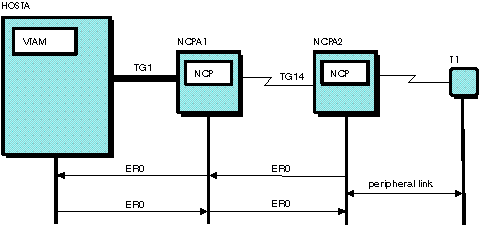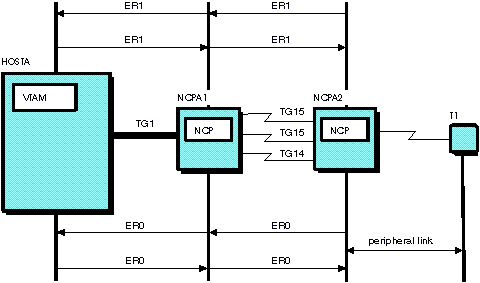The physical path between two subarea nodes is an explicit route.
- Explicit route (ER)
- An explicit route is an ordered set of
subarea nodes and transmission groups along a path between communicating
subarea nodes, including:
- The endpoint subareas
- Any subareas between the endpoint subareas
- The transmission group used to connect each subarea pair along
the route
In connecting one endpoint subarea to another, an explicit
route cannot include the same subarea more than once.
- Forward explicit route
- Explicit routes originating in the host are forward explicit routes
and are numbered 0 through 15 (0 through 7 with releases before NCP
Version 4 Release 3.1 or Version 5 Release 2.1 or if ERLIMIT is set
to 8).
- Reverse explicit route
- Reverse explicit routes terminate in the host and must use the
same set of subarea nodes and transmission groups as their corresponding
forward explicit route. They are also numbered 0 through 15 (0 through
7 with releases before NCP Version 4 Release 3.1 or Version 5 Release
2.1 or if ERLIMIT is set to 8), but they do not have to have the same
explicit route number as the corresponding forward explicit route.
- Transmission group (TG)
- A transmission group consists of a single SDLC link or data channel
between two subarea nodes, or of a logical combination of up to eight
parallel SDLC links between communication controller subarea nodes.
Transmission groups are numbered 1 through 255.
Transmission groups
appear as one link to the path control network, even if the transmission
group contains parallel SDLC links. Data flows across a specific transmission
group during a session, but not across a specific link in a transmission
group. The specific link used within the transmission group is determined
dynamically depending on which link is available at the time.
Transmission groups can also exist in parallel, creating multiple
explicit routes between two subareas. For instance, parallel SDLC
links between adjacent communication controller subarea nodes can
be divided into multiple transmission groups. A maximum of 16 parallel
transmission groups are allowed between adjacent subarea nodes.
Parallel links in one or more transmission groups can be active
and carry data simultaneously. Each parallel link is controlled (activated
and deactivated) independently of the others.
- Routing tables
- An entire explicit route is not defined to each subarea node along
a path; instead, each subarea node has its own routing table that
contains only the information that path control needs to forward data
to the next subarea along the route (the adjacent subarea). Given
the explicit route number being used and the destination subarea,
the table provides the adjacent subarea to which the data is forwarded
and the transmission group over which the data is forwarded.
- Peripheral link
- A peripheral link is the
portion of the route between a subarea node and a peripheral node.
A peripheral node uses local addresses for routing and requires boundary
function assistance from an adjacent subarea node to communicate with
a nonadjacent subarea node.
- NCP/Token-Ring Interconnection (NTRI) Nondisruptive Route Switching
(NDRS)
- Token-Ring networks often contain bridges that allow multiple
physical paths between two nodes. NCP Version 5 Release 3 and later
provides the NDRS function that attempts to find an alternate route
through the token ring network. NCP invokes this function automatically
when timeout conditions occur and all retries have been exhausted
for a connection.
VTAM® and
NCP Version 7 Release 8 and later provide the MODIFY NCP operator
command. This command can be used to force NCP to initiate NDRS for
a 3745 token-ring attached subarea connection. This function is useful
in order to switch back to the original route (when recovered) after
NCP has automatically invoked NDRS to find a backup route. It can
also be used at any time to search for a faster route through the
token-ring network. NCP Version 7 Release 7 and later will generate
a "Token-Ring Path Switch Notification" Generic Alert upon successful
completion of NDRS. See z/OS Communications Server: SNA Operation for further information.
In the sample network configuration shown in Figure 1, HOSTA and peripheral node T1 can communicate over two explicit
routes, one in each direction. Both explicit routes have been numbered
0 and include HOSTA, NCPA1, NCPA2, and transmission groups 1 and 14.
A data channel assigned to TG1 connects HOSTA with NCPA1. An SDLC
link assigned to TG14 connects NCPA1 and NCPA2. Each subarea node
contains a routing table to route data between subareas along ER0.
Figure 1. One explicit route in each direction
In the sample network configuration in Figure 2, parallel SDLC links connect NCPA1 and NCPA2. Two different
explicit routes between HOSTA and NCPA2 are now available in either
direction. All routes take TG1 between HOSTA and NCPA1, but data flows
between NCPA1 and NCPA2 over TG14 for ER0 or TG15 for ER1. The routing
tables have been updated to reflect the additional explicit routes.
Figure 2. Two explicit routes in each direction
 z/OS Communications Server: SNA Network Implementation Guide
z/OS Communications Server: SNA Network Implementation Guide
 z/OS Communications Server: SNA Network Implementation Guide
z/OS Communications Server: SNA Network Implementation Guide





 Copyright IBM Corporation 1990, 2014
Copyright IBM Corporation 1990, 2014